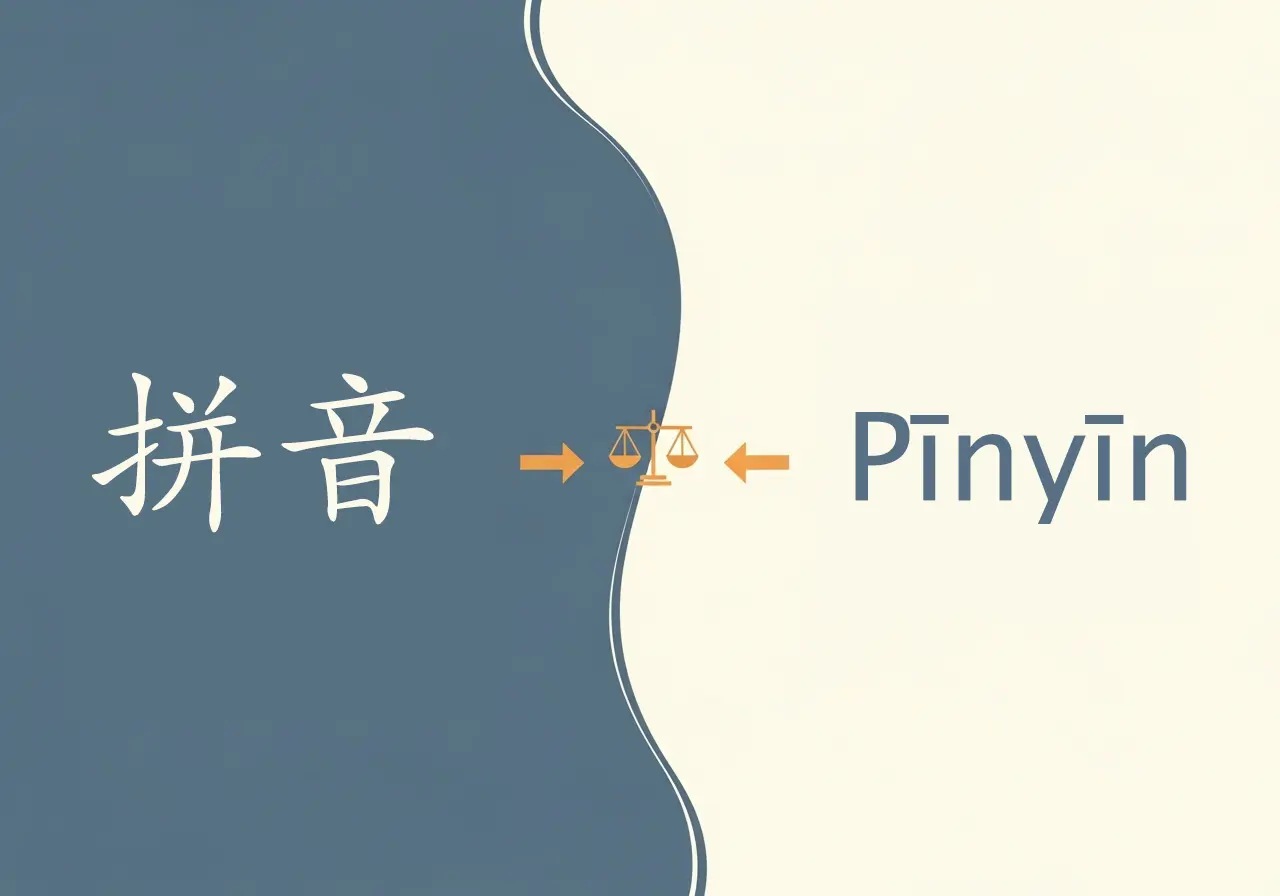
TL;DR — Quick Summary
- Chinese characters (汉字 hànzì) are a logographic writing system encoding meaning.
- Pinyin (拼音 pīnyīn) is a phonetic system that uses the Latin alphabet to represent pronunciation.
- Characters carry meaning and clarify homophones; Pinyin supports learning, pronunciation, and typing.
- Use both: characters for reading and writing, Pinyin for pronunciation and input.
What’s the difference between Chinese characters and Pinyin?
The difference between Chinese characters and Pinyin lies in their core function:
- Chinese characters express meaning through unique logograms, according to the Wikipedia article on Chinese characters.
- Pinyin spells pronunciation using Latin letters and tone marks, as described by Wikipedia’s entry on Hanyu Pinyin.
Characters answer “What does it mean?” while Pinyin answers “How do I say it?”
For example:
- 好 → hǎo → “good.”
The character conveys meaning, while Pinyin shows pronunciation.
Chinese Characters (汉字): A Writing System Based on Meaning
Chinese characters are logograms—each symbol represents a morpheme or meaning-bearing unit, not a combination of alphabetic sounds.
As explained by Encyclopaedia Britannica’s overview of Chinese writing, a single syllable can map to multiple characters with distinct meanings:
| Pinyin | Character | Meaning |
|---|---|---|
| fēng | 风 | wind |
| fēng | 峰 | mountain peak |
| fēng | 蜂 | bee |
| fēng | 丰 | abundant |
Each symbol often combines semantic radicals (meaning clues) and phonetic components (sound hints), as outlined in the Wikipedia classification of Chinese characters.
For instance, the radical “氵” in “海 (hǎi)” indicates relation to water.
👉 Learn more about reading basics in Most Common Chinese Characters for Beginners.
Takeaway: Characters encode meaning and reduce ambiguity in a language rich in homophones.
Pinyin (拼音): A Tool for Pronunciation and Tones
Hanyu Pinyin was created in the 1950s to teach standard Mandarin pronunciation and assist with literacy.
Pinyin uses the Latin alphabet plus tone marks (ˉ ˊ ˇ ˋ) to indicate pitch.
| Pinyin | Tone | Meaning |
|---|---|---|
| mā | 1st | mother |
| má | 2nd | hemp |
| mǎ | 3rd | horse |
| mà | 4th | scold |
Pinyin is not a replacement for characters—it is a phonetic learning and typing tool, helpful for:
- Pronunciation training
- Typing and digital input
- Dictionary lookup
Takeaway: Pinyin bridges spoken Mandarin with written Chinese.
Characters vs. Pinyin: A Side-by-Side Comparison
| Aspect | Chinese Characters (汉字) | Pinyin (拼音) |
|---|---|---|
| Type | Logographic | Phonetic |
| Represents | Meaning | Pronunciation |
| System | Radicals & strokes | Latin letters & tones |
| Tone Marking | Contextual | Explicit tone marks |
| Used By | Native readers | Learners, IME users |
| Example | 你好 | nǐ hǎo |
As summarized by the Wikipedia entry on Written Chinese, both systems complement each other—Pinyin helps you speak, characters help you read.
When Should You Use Characters and When Should You Use Pinyin?
- Characters are used in reading, writing, signage, and everyday communication.
- Pinyin is mainly used for learning pronunciation and typing input, especially for beginners.
Even native speakers type by inputting Pinyin and selecting the correct character (e.g., typing “zhongguo” → choosing “中国”).
Why Pinyin Alone Isn’t Enough
Mandarin has many homophones, and Pinyin alone cannot distinguish them clearly.
The syllable shi can correspond to dozens of characters:
- 是 (to be)
- 十 (ten)
- 事 (matter)
- 诗 (poem)
Only characters clarify meaning. To achieve fluency and literacy, both systems are essential.
How to Read Pinyin Like a Native
Pinyin breaks down pronunciation into initials, finals, and tones:
- Initials: beginning consonant sounds (b, p, m, d, etc.)
- Finals: vowel patterns (a, ai, ao, ang, etc.)
- Tones: pitch patterns that change meaning
The Latin letters do not match English sounds directly:
- “q” → sounds like “chee”
- “x” → soft “sh”
- “zh” → “juh” (retroflex)
👉 For tone practice, see The language interacive tool for PinYin table.
How Chinese People Learn Both Systems
Chinese schoolchildren learn Pinyin first for pronunciation and tones, then move to characters for literacy.
This gradual approach mirrors how foreign learners should progress—sound before symbol.
A smart learning path:
- Start with Pinyin pronunciation and tone drills.
- Add basic characters early on.
- Practice digital input using both.
👉 Practice the Chinese Writing System,see Learn Chinese Writing System with radicals table.
Common Learner Mistakes (and Easy Fixes)
| Mistake | Problem | Fix |
|---|---|---|
| Relying on Pinyin only | Prevents reading fluency | Learn characters alongside |
| Ignoring tone marks | Miscommunication | Practice with tone pairs daily |
| Using English letter sounds | Incorrect pronunciation | Focus on Mandarin phonetics |
| Learning isolated words | Misses context | Study through phrases |
Balanced practice builds stronger comprehension and pronunciation.
Why Both Systems Matter for Modern Learners
Pinyin offers accessibility and pronunciation clarity, while characters connect learners with Chinese literature, calligraphy, and cultural heritage.
As the Linguistic Society of America points out, Chinese writing is one of the oldest continuously used systems in the world.
Explore related topics to strengthen your Mandarin foundation:
- Mastering Chinese Pinyin: The Foundation for Learning Mandarin
- Formal Ways to Say Hello in Chinese for Business
- How Are You in Mandarin: Phrases, Tone & Cultural Nuance
- How to Say Bye Bye in Chinese (With Tone Tips & Examples)
Final Thoughts
The difference between Chinese characters and Pinyin reflects two complementary systems—one visual, one phonetic.
Characters embody history and meaning; Pinyin simplifies learning and pronunciation.
Together, they make Mandarin both accessible and deeply expressive.